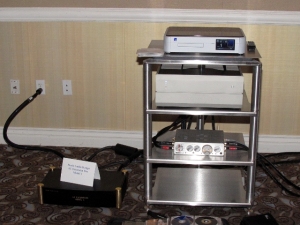Well I’m back from the show in Las Vegas; this marks 24 years going to CES or T.H.E Show. Making next year my 25th time, it doesn’t feel like almost 25 years, time really flies. This year, we were blessed with a good room and great synergy between all the equipment.
We were running two different systems; one half of the day we would run a tube system using the KR single mono blocks driven by the Nagra PLP preamp. The other half of the day we would use solid state using the Vitus integrated SS-050 amp. The front-end consists of the PS Audio Prefect wave transport using I2S interface into a Stalh~Tek Vekian D/A. The cables consisted of Proteus Provectus Preasto Revision RCA, Balanced, and Bi-wire speaker cables. The AC power cords were the Purist Limited Edition and the Purist Canorus being feed by the new Purist AC extension Box Model 1. Below is a Picture of the front-end.

Audio Prefect wave transport, Stalh~Tek Vekian D/A, Nagra PLP preamp, and Purist AC extension Box Model 1
The room dimensions were 35’ by 25’ with a 10’ ceiling. It was a big room, but the Typheous speakers with 92 Db efficiency, it’s 400 plus lbs, and 6’ height was up to the task. We added room treatment and damping in the room (Michael Green of Room tunes helped with their products). We also draped half the room, and added a sound proof wall.
The sound, after all the tweeting and adjusting, was one of the best sounds I’ve had in a show. The imaging was what you dream about! We used several different music tracks to test the system, below is a list of some of those tracks, and what we liked from each one.
Well, after a long and hard setup Per, the designer from Peak-consult, and I went to the bar and started talking about our favorite classical melodies. So, instead of 100 beers on the wall we listed, yes, 100 Favorite Classical Melodies. If you would like to take a look at our list, click here (pdf file).
Per is going to meet me at the Munich Show in Germany, and we are going to name our favorite Jazz. Now that will be interesting.
On a side note, I would really like to talk about the digital front end, after living the last few months with I2S and using the Stalh Tek Vekian D/A, I feel that digital has made a huge move forward in sound quality. I found my self using the Digital over my Turntable. If you have a chance to try the I2S interface please do and give me your feedback.

